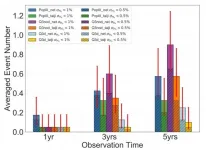(Press-News.org) University of Virginia School of Medicine scientists have developed important new resources that will aid the battle against cancer and advance cutting-edge genomics research.
UVA's Chongzhi Zang, PhD, and his colleagues and students have developed a new computational method to map the folding patterns of our chromosomes in three dimensions from experimental data. This is important because the configuration of genetic material inside our chromosomes actually affects how our genes work. In cancer, that configuration can go wrong, so scientists want to understand the genome architecture of both healthy cells and cancerous ones. This will help them develop better ways to treat and prevent cancer, in addition to advancing many other areas of medical research.
Using their new approaches, Zang and his colleagues and students have already unearthed a treasure trove of useful data, and they are making their techniques and findings available to their fellow scientists. To advance cancer research, they've even built an interactive website that brings together their findings with vast amounts of data from other resources. They say their new website, bartcancer.org, can provide "unique insights" for cancer researchers.
"The folding pattern of the genome is highly dynamic; it changes frequently and differs from cell to cell. Our new method aims to link this dynamic pattern to the control of gene activities," said Zang, a computational biologist with UVA's Center for Public Health Genomics and UVA Cancer Center. "A better understanding of this link can help unravel the genetic cause of cancer and other diseases and can guide future drug development for precision medicine."
Bet on BART
Zang's new approach to mapping the folding of our genome is called BART3D. Essentially, it compares available three-dimensional configuration data about one region of a chromosome with many of its neighbors. It can then extrapolate from this comparison to fill in blanks in the blueprints of genetic material using "Binding Analysis for Regulation of Transcription", or BART, a novel algorithm they recently developed. The result is a map that offers unprecedented insights into how our genes interact with the "transcriptional regulators" that control their activity. Identifying these regulators helps scientists understand what turns particular genes on and off - information they can use in the battle against cancer and other diseases.
The researchers have built a web server, BARTweb, to offer the BART tool to their fellow scientists. It's available, for free, at http://bartweb.org. The source code is available at https://github.com/zanglab/bart2. Test runs demonstrated that the server outperformed several existing tools for identifying the transcriptional regulators that control particular sets of genes, the researchers report.
The UVA team also built the BART Cancer database to advance research into 15 different types of cancer, including breast, lung, colorectal and prostate cancer. Scientists can search the interactive database to see which regulators are more active and which are less active in each cancer.
"While a cancer researcher can browse our database to screen potential drug targets, any biomedical scientist can use our web server to analyze their own genetic data," Zang said. "We hope that the tools and resources we develop can benefit the whole biomedical research community by accelerating scientific discoveries and future therapeutic development."
INFORMATION:
Findings Published
The researchers have published their findings in a trio of new scientific papers: They describe BART3D in the scientific journal Bioinformatics in an article by Zhenjia Wang, Yifan Zhang and Chongzhi Zang; they describe BARTweb in NAR Genomics and Bioinformatics in an article by Wenjing Ma, Zhenjia Wang, Yifan Zhang, Neal E. Magee, Yayi Feng, Ruoyao Shi, Yang Chen and Chongzhi Zang; and they describe BART Cancer in NAR Cancer in a paper by Zachary V. Thomas, Zhenjia Wang and Chongzhi Zang.
Chongzhi Zang is a member of the School of Medicine's Department of Public Health Sciences and Department of Biochemistry and Molecular Genetics. He is also part of UVA's Department of Biomedical Engineering, a collaboration of the School of Medicine and the School of Engineering.
The work was supported by the National Institutes of Health, grants R35GM133712 and K22CA204439; a Phi Beta Psi Sorority Research Grant; and a Seed Award from the Jayne Koskinas Ted Giovanis Foundation for Health and Policy.
To keep up with the latest medical research news from UVA, subscribe to the Making of Medicine blog at http://makingofmedicine.virginia.edu.
Hundreds of antibiotic resistant genes found in the gastrointestinal tracts of Danish infants
Danish one-year-olds carry several hundred antibiotic resistant genes in their bacterial gut flora according to a new study from the University of Copenhagen. The presence of these genes is partly attributable to antibiotic use among mothers during pregnancy.
An estimated 700,000 people die every year from antibiotic resistant bacterial infections and diseases. The WHO expects this figure to multiply greatly in coming decades. To study how antibiotic resistance occurs in humans' ...
The Hubble parameter is one of the central parameters in the modern cosmology. Their values inferred from the late-time observations are systematically higher than those from the early-time measurements by about 10%. This is called the "Hubble tension". To come to a robust conclusion, independent probes with accuracy at percent levels are crucial. With the self-calibration by the theory of general relativity, gravitational waves from compact binary coalescence open a completely novel observational window for Hubble parameter determination. Hence, it can shed some light on the Hubble tension. Depends on whether being associated with ...
A new rapid coronavirus test developed by KAUST scientists can deliver highly accurate results in less than 15 minutes.
The diagnostic, which brings together electrochemical biosensors with engineered protein constructs, allows clinicians to quickly detect bits of the virus with a precision previously only possible with slower genetic techniques. The entire set-up can work at the point of patient care on unprocessed blood or saliva samples; no laborious sample preparation or centralized diagnostic laboratory is required.
"The combination of state-of-the-art ...
Dust storms are often defined as catastrophic weather events where large amounts of dust particles are raised and transported by strong winds, characterized by weak horizontal visibility (< 1 km), suddenness, short duration, and severe destruction. Over the past few decades, the observed dust storms in northern China showed generally decreasing trends (Fig. 2), which could have made the dust storms "out of sight" of the public gradually. Yet a most recent strong dust storm event originated from Mongolia since mid-March this year exerted serious impacts on most areas in northern China, ...
RICHLAND, Wash.--As the Clean Energy Transformation Act drives Washington state toward carbon-free electricity, a new energy landscape is taking shape. Alongside renewable energy sources, a new report finds small modular reactors are poised to play an integral role in the state's emerging clean energy future.
The technology could help fill a power source gap soon to be left by carbon-emitting resources like coal and natural gas, which will be phased out in coming years, according to a report composed by researchers at the U.S. Department of Energy's Pacific Northwest National Laboratory and Massachusetts Institute of Technology.
"Nuclear energy is a reliable source of baseload electricity," said PNNL's ...
Modern genetic research often works with what are known as reference genomes. Such a genome comprises data from DNA sequences that scientists have assembled as a representative example of the genetic makeup of a species.
To create the reference genome, researchers generally use DNA sequences from a single or a few individuals, which can poorly represent the complete genomic diversity of individuals or sub-populations. The result is that a reference does not always correspond exactly to the set of genes of a specific individual.
Until a few years ago, it was very laborious, expensive and time-consuming to generate ...
Many eye diseases are associated with a restricted blood supply, known as ischaemia, which can lead to blindness. The role of the protein tenascin-C, an extracellular matrix component, in retinal ischaemia was investigated in mice by researchers from Ruhr-Universität Bochum (RUB). They showed that tenascin-C plays a crucial role in damaging the cells responsible for vision following ischaemia. The results were published online by the team in the journal Frontiers in Neuroscience on 20 May 2021.
As part of the research, the team around Dr. Susanne Wiemann and Dr. Jacqueline Reinhard from the Department of Cell Morphology and Molecular Neurobiology at RUB collaborated with Professor Stephanie Joachim's research group from ...
Included in the vast fallout stemming from the COVID-19 pandemic, scientists are paying closer attention to microbial infections and how life forms defend against attacks from pathogens.
Research led by University of California San Diego scientists has shed new light on the complex dynamics involved in how organisms sense that an infection is taking place.
UC San Diego Assistant Project Scientist Eillen Tecle in Professor Emily Troemel's laboratory (Division of Biological Sciences) led research focusing on how cells that are not part of the conventional immune system respond to infections when pathogens attack. Scientists have conducted extensive research on so-called "professional" immune cells that are defensive specialists. Much less is known about how "non-professional" cells ...
Alzheimer's disease - also called dementia - where memory and cognitive functions gradually decline due to deformation and death of neurons, and Parkinson's disease that causes tremors in hands and arms impeding normal movement are major neurodegenerative diseases. Recently, a research team at POSTECH has identified the structure of the agent that causes Alzheimer's and Parkinson's diseases to occur together.
A research team led by Professor Joon Won Park and Ph.D. candidate Eun Ji Shin of the Department of Chemistry at POSTECH investigated the surface structure of hetero-oligomers found in the overlap of Alzheimer's disease and Parkinson's disease, using an atomic force microscopy (AFM) to reveal their structural identity. This study was featured as the ...
While the plates carry water to the Earth's interior, phase transitions of dry olivine, the main mineral in the plates, are thought to be responsible for deep-focus earthquakes and plate deformation. This study resolves the contradiction of the presence of dry olivine even in wet plates. Takayuki Ishii, a researcher at the Center for High Pressure Science & Technology Advanced Research (HPSTAR), China and the Bavarian Institute of Geosciences, University of Bayreuth, Germany, and Eiji Otani, a professor emeritus at Tohoku University, used high-pressure and high-temperature experiments to determine the water content of olivine under ...







